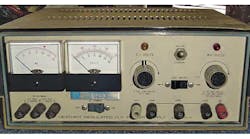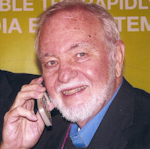The History of Personal Computers, Part 2: The Heathkit Story
>> Electronic Design Resources
.. >> Library: Article Series
.. .. >> Topic: Looking Back at Electronic History
.. .. .. >> The History of Personal Computers
If you read my Part 1 blog, you know that I developed a computer kit for McGraw Hill/NRI back in 1972. I left MH in 1973 to go to the Heath Company. I went there to start Heath’s education and publishing business. And that I did with a launch of a line of self-study courses in electronics with kit trainers. It was a great success with individuals and technical colleges. However, I had in mind making a kit computer too.
Heath was not interested in creating a computer kit even though it offered two analog (yes, analog) computer kits using pluggable vacuum tube amplifiers. However, the discussion and consideration of a computer kit was on-going. The first effort was to define an educational product, a microprocessor trainer and course based on the Motorola 6800. That worked out well as with microprocessors being new to electronics there was an overwhelming need for education in this new field. The ET-3400 was the result and it was a huge success.
Later, in 1975 we decided to do something about a more formal computer kit given the success of MITS and others with kit products. So in addition to my education product duties I took on the job of defining a product line with the help of Heath Manager of Design Engineering Chas Gilmore. With minimal in-house computer expertise, we decided to try to buy a design and “kit” it. We tried with Apple and were rudely turned down by a young Steve Jobs. We tried with the minicomputer giants Digital Equipment Corporation (DEC) and Data General both of whom said no. DEC eventually agreed. So we decided to make our own. The result was two computers, a video terminal, a paper tape reader/punch and a printer.
The main computer was the H8 based on the 8080 as were most of the earliest kits. The second was the H11 based on Digital Equipment Corporation (DEC) 16-bit LSI11. The terminal was called the H9 and the paper tape peripheral was the H10. The H8 had sloping front panel with a numerical keypad and LED display. Data entry and display was in octal. Yes, octal and not hex as it probably should have been. You can see how we were influenced by the DEC computers as some of us had PDP-8 and/or PDP-11 experience. Anyway, the H8 had a 4KB RAM using Motorola’s 1K static RAM chips. We had to fly to Motorola in Austin to beg for our allotment of RAM chips to make production. The static RAM cost more than dynamic RAM at the time but it avoided the horrible problems that MITS and others had with DRAM. The I/O was an audio cassette interface.
The H9 terminal had a standard keyboard and 12-inch mono CRT with 12 lines x 80 characters and an RS-232 interface. The H10 reader/punch ran at a blazing 10 cps. It did not sell well as everyone used the audio cassette interface instead. It was a dumb idea in retrospect.
The H11 came along later as DEC agreed to supply their LSI-11 in prewired form and provided a license to distribute their RT-11 operating system. The H11 had a dual 8-inch floppy drive accessory. The whole thing was expensive but after all it was almost a minicomputer in kit form. Few appreciated this at the time.
As for software we tried to get CP/M from Gary Kildall but he said no. We tried to get Microsoft BASIC but we decided against it. Bill Gates visited Heath and said we could use it for an outrageous per license cost. He was arrogant and discourteous and our president at the time Dave Nurse kicked him out. We ended up hiring our first real programmer who wrote both an OS and a version of BASIC.
We launched the computer line in 1977. It was an instant success despite the competition from the Apple II and TRS-80 which also launched that year. Within a year we were making $40 million annually with computers putting Heath Company well over the $100 million revenue mark. We followed up with floppy drives for the H8 and an all-in-one computer called the H89, a terminal and floppy in a box using a Z80. It too was a huge success.
In 1979, Heath parent company Schlumberger sold the company to Zenith. Zenith wanted a way into the computer business. They took the computer product line away and created Zenith Data Systems. The Heathkit business continued in the kit mode. ZDS sold the H89 and went on to define a line of 286 and 386-based computers in the following years. ZDS was ultimately sold to a French company Groupe Bull 1989 and later to Packard Bell. Once the IBM PC came along in 1981, the remaining company tried to compete but could not and ultimately folded.
With the sale of the computer product line to Zenith, I became VP of the educational business which had grown to about $15 million in the meantime. I expanded the line by defining and developing Heath’s robot kit called HERO. It too was a huge success.
The Heath kit business and related businesses folded in 1992 after several acquisitions but the educational products business called Heathkit Continuing Education soldiered on until 2012 when it finally faded away into bankruptcy.
There have been rumors of Heathkit returning from bankruptcy. Those behind Heathkit must be planning a return as their website offers a survey to find out what potential customers want in a kit. I suspect if they do return Heathkit will focus on amateur radio products and beginner kits. That once famous name is no longer recognized or fondly remembered by the younger generation. It will be interesting to see what happens given the rejuvenation of a whole new DIY movement today. I wish them well.
>> Electronic Design Resources
.. >> Library: Article Series
.. .. >> Topic: Looking Back at Electronic History
.. .. .. >> The History of Personal Computers

